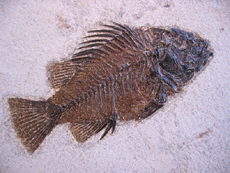
 |
 |
| Class Osteichthyes | |
| As
a group, fish account for some important first appearances
in the fossil record. Fish were the first vertebrates,
the first vertebrates with jaws, the first vertebrates
to evolve
lungs, and the first vertebrates with bony skeletons. Their
evolutionary success was not limited to aquatic environments
as fish are
the ancestors to all land vertebrates. To this day bony
fishes
(class Osteichthyes) are the most abundant and diverse
vertebrates. At over 20,000 species, bony fish account
for half of all
known living vertebrates (Dixon, 1988, p. 36). Bony fish
have skeletons made of bone and a gas-filled chamber in
the form of a swim bladder or lung. Osteichthyans range
from
the Silurian to recent times. Bony fish are divided into
two clades, the Actinopterygii and Sarcopterygii (Benton,
2005, p. 62). Lobe-Finned
Fish Basal Actinopterygians Basal actinopterygians are sometimes referred to as chondrosteans, although this is a paraphyletic grouping. Chondrosteans underwent an adaptive radiation from the Carboniferous to the Triassic. These primitive ray-finned fish were once called palaeoniscids, also a paraphyletic grouping. The basal actinopterygians are characterized by thick bony articulated rhomboid shaped scales covered with a shiny layer of enamel called ganoin. Gaoid scales have been found in Silurian and Devonian deposits. Basal actinopterygians had heavy bony skulls with large eyes and a short snout. Their bony jaws were capable only of a snapping bite. The anal fins as well as the paired pelvic and pectoral fins were heavy and triangular in shape. The caudal fin was heterocercal. The first complete actinopterygian specimens are known from Devonian deposits. Basal actinopterygians became the dominant fish in the Permian and disappear in the Cretaceous. Basal Neopterygians The neopterygians clade (superdivision Neopterygii) arose in the Late Permian and includes gars, semionotids and other extinct forms, bowfins, and the teleosts. Basal neopterygians are sometimes referred to as holosteans, which is a paraphyletic group. Holosteans underwent an adaptive radiation from the Triassic through the Jurassic. The teleost radation started in the Triassic and continues to this day. Neopterygians are characterized by modifications in the jaw structure, braincase, tail, and scales. The upper jawbones were freed from the cheekbones, which permits the mouth to open wider and allows for the development of stronger muscles. This jaw structure also produced a sucking effect that helps to draw food into the mouth. The tail fin became more symmetrical, but not totally homocercal. Evolutionary trends in scales included a change from rhomboid to circular shape, thinning, increased flexibility, as well as the loss of enamel covering. The holostean radiation was followed by the radiation of a more advanced group of neopterygians, the teleosts. Modern Fish: The Teleosts The
radiation of teleosts (subdivision
Teleostei) began in the Triassic and accelerated during the Cretaceous.
Teleosts make up 99% of
all living fish and account for half of all living vertebrates
(Prothero, 1998, p. 352). The flexibility of the jawbone increases
with the teleosts allowing them to protrude their mouth in
a circular shape, sucking up their food, rather than biting hard.
The skull of the teleost is lightweight and flexible. The swim
bladder evolved into a more efficient organ in the teleost
making them neutrally buoyant. This allowed the pelvic and pectoral
fins
to
become thin
and
flexible adapted for fine
steering
control and hovering. In more primitive ray-finned fish heavy fins
were designed primarily for thrust. The vertebrae of teleosts become
increasingly ossified. Teleosts have a symmetrical, fully homocercal
caudal fin with distinctive radiating
elements
known
as uroneurals modified from the spinal column. The bodies of advanced
teleosts became covered with thin, flexible, rounded, overlapping
scales with no enamel. Knightia is the state fossil for Wyoming. The
2016 Science Olympiad Fossil List includes the superclass Osteichthyes (Bony Fish). The ray-finned fish are listed under the class Actinopterygii. The Coelacanth is listed under the class Sarcoptergii (lobed-finned) and order Coelacanthiformes. The genus Tiktaalik is also included under this order. To learn more about Tiktaalik see the amphibian section of our website. |
|
|
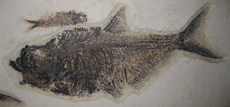 Diplomystus sp. Green River Formation Eocene Wyoming, USA 48 cm long |
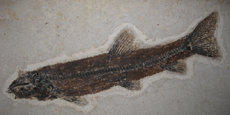 Notogoneus sp. Green River Formation Eocene Wyoming, USA 48 cm long |
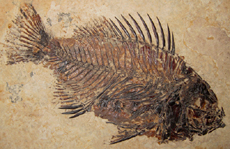 Priscacara liops Green River Formation Eocene Wyoming, USA 12 cm long |
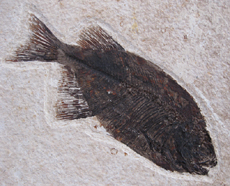 Phareodus sp. Green River Formation Eocene Wyoming, USA 16 cm long |
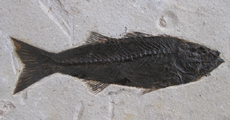 Mioplosus sp. Green River Formation Eocene Wyoming, USA 20 cm long |
Bibliography |
|
Benton,
M.J. (2005) Vertebrate Palaeontology [3rd Edition].
Blackwell Publishing: Main, USA. Ridley, M. (2009).
The Darwin Bicentennial Part II: Modern Darwins. National Geographic, February 2009, Vol. 215, No. 2. |
|











